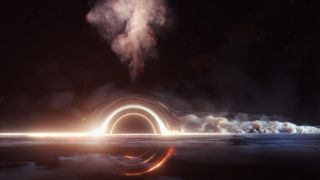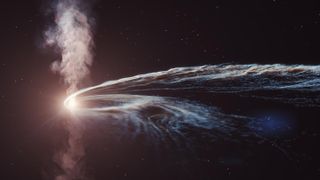
For the first time ever, scientists have received mysteriously delayed signals from two supermassive black holes that snacked on stars in their vicinity.
In the first case, a black hole weighing as much as 30 million suns located in a galaxy approximately 750 million light-years away gobbled up a star that passed too close to its edge. Light from the event was spotted in April 2019, but six months later a telescope in Antarctica captured an extremely high-energy and ghostly particle — a neutrino — that was apparently burped out during the feast.
A second incident involved a supermassive black hole with around 1 million times the sun's mass in a galaxy about 700 million light-years away. Observatories spied it lunching on a star in August 2015 and then going quiet before a sudden burst of radio waves emerged in February 2016 and then again, almost four years later, in July 2019.
Related: 10 huge black hole findings from 2020
Both occurrences involve what's known as a tidal disruption event (TDE), where a supermassive black hole shreds a star to pieces using its colossal gravitational pull — essentially an extreme version of how the moon's gravitational pull raises tides on the Earth. Such cosmic events are still not well understood and these two new findings should greatly help astronomers unlock their inner workings.
"Every time we detect a new TDE, there can always be something exciting and unexpected associated with it," Jane Dai, who studies high-energy astrophysics at the University of Hong Kong, told Live Science. "So there is a lot of new physics that can be done," added Dai, who was not involved in either finding.
Researchers classify tidal disruption events as "transient" phenomena, since they typically flare over the course of a few days and then dim again. What exactly is creating the light in such cases is still not entirely clear, Assaf Horesh, an astronomer at the Hebrew University of Jerusalem in Israel and co-author on two papers about the new events, told Live Science.
Sign up for the Live Science daily newsletter now
Get the world’s most fascinating discoveries delivered straight to your inbox.
As the supermassive black hole tears apart its stellar meal, the star becomes "spaghettified" into a long thin stream. This torrent of material wraps around the black hole and is thought to produce a jet of energy as it circles like water going down a drain, though other models predict that some of the former star might explode outward and interact with surrounding gas and dust, generating the flare, Horesh said.

Given the extreme environment surrounding the black hole, particles can become greatly accelerated in processes akin to atom smashers like the Large Hadron Collider in Geneva, Switzerland. Neutrinos are tiny specks roughly 500,000 times lighter than an electron and, being neutral (having no charge), don't interact with much as they fly through the cosmos.
This allowed a single neutrino to travel outward from the first TDE and head toward Earth, eventually appearing in a square-kilometer-size instrument known as the IceCube Neutrino Observatory buried in the Antarctic ice. Researchers labeled the detection IC191001A and calculated that it had nearly 1 quadrillion electronvolts of energy, making it among the most powerful neutrinos IceCube has ever seen, according to one of the new papers, which was published Feb. 22 in the journal Nature Astronomy.
While physicists have predicted that neutrinos are produced in tidal disruption events, astronomers have never tied a neutrino back to a particular TDE, making this a spectacular first. As to why it arrived six months after the event itself, "I have no clue," said Horesh.
A similar mystery surrounds the second study he led, also in Nature Astronomy . In that case, optical light — the kind our eyes see — was seen to flare from a snacking black hole and then fade away, as per usual for these phenomena.
Horesh and his co-authors decided to conduct follow-up studies using the Karl Jansky Very Large Array (VLA) telescope in New Mexico, which detects radio waves. They saw nothing coming from the black hole for months and then, suddenly, six months after the initial event, a bright radio flare. Even stranger, VLA data collected almost four years later showed another curious burst of radio energy.
"Someone can make up a story for why we saw something six months later," Horesh said. "There is nothing to explain why it should flare up, decay and then flare up again. It's really interesting."
He points to the need for new models that can explain these delayed signals. His team speculates that part of the jet of energy is coming out at an odd angle, producing a flaring pattern that is sometimes seen and sometimes not as the accretion disk spins. Another possibility is that the stellar remains are driving shock waves that move slowly through material surrounding the black hole, which produce energetic emissions at later times, though no one really knows.
But given that these incidents now seem to last longer than originally suspected, Horesh is looking forward to being able to detect more tidal disruption events that could yield insights into their nature.
Dai, too, is excited about the prospect of opening up ways to study the mysteries of TDEs. "These events are ideal laboratories to learn about black holes," she said, giving researchers important clues about how material accretes around them and produces jets and flares.
The Vera C. Rubin Observatory in Chile, which is expected to begin collecting data this year, could theoretically see hundreds of new TDEs, she added; and other upcoming space-based instruments from Europe and China should add to this bounty.
"The future for the field is very bright," she said.
Originally published on Live Science.

Adam Mann is a freelance journalist with over a decade of experience, specializing in astronomy and physics stories. He has a bachelor's degree in astrophysics from UC Berkeley. His work has appeared in the New Yorker, New York Times, National Geographic, Wall Street Journal, Wired, Nature, Science, and many other places. He lives in Oakland, California, where he enjoys riding his bike.
Most Popular

